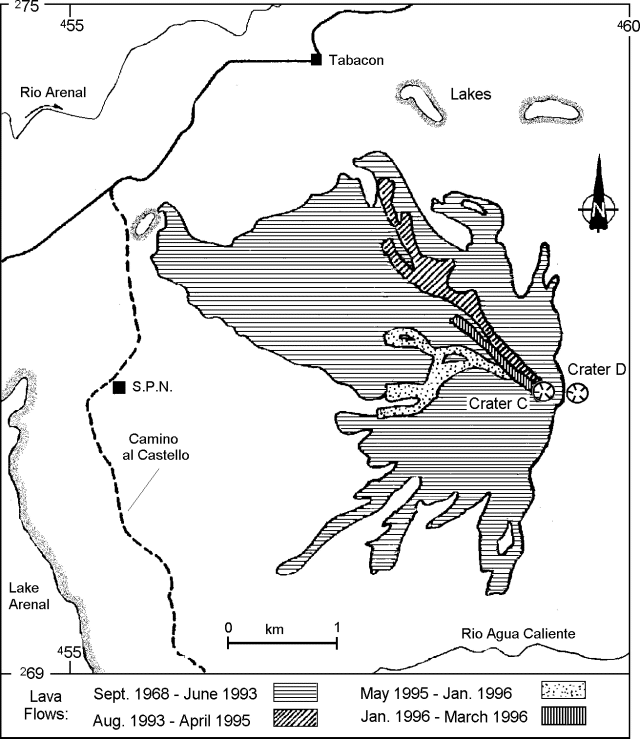Report on Arenal (Costa Rica) — March 1996
Bulletin of the Global Volcanism Network, vol. 21, no. 3 (March 1996)
Managing Editor: Richard Wunderman.
Arenal (Costa Rica) Continued eruptions and recently updated map of lava flows
Please cite this report as:
Global Volcanism Program, 1996. Report on Arenal (Costa Rica) (Wunderman, R., ed.). Bulletin of the Global Volcanism Network, 21:3. Smithsonian Institution. https://doi.org/10.5479/si.GVP.BGVN199603-345033
Arenal
Costa Rica
10.463°N, 84.703°W; summit elev. 1670 m
All times are local (unless otherwise noted)
During February and March, Crater C continued to emit gas, lava, and sporadic Strombolian eruptions. For both months, OVSICORI-UNA reported that the intensity of explosive activity was slightly below that of January, however, columns still rose ~1 km. Prevailing winds blew towards the NW, W, and SW. Arenal continued to cause acidic rains and to eject volcanic bombs, blocks, and ash. The volcano's steep slopes and receding vegetation have led to gullying in unconsolidated material and cold avalanches down local drainages.
ICE reported the distribution of lava flows down Arenal's W slopes (figure 76). A flow active from May 1995 through early January 1996 ceased and a new one trending WNW began in late January, its downslope end reaching 1,200-m elevation in early March. Also, on the N flank in early March, some rolling blocks destroyed forest down to 1,150 m elevation. Deposits reminiscent of those from pyroclastic flows were found in late December at 950 m elevation.
 |
Figure 76. Sketch map of Arenal area showing distribution of lavas as of March 1996. Courtesy of G. J. Soto. |
ICE noted that December explosions were ~15-30 minutes apart; after mid-January the explosions were ~27 ± 21 minutes apart (1 sigma standard deviation); steam often vented in the N quadrant of Crater C. Nightime observers saw cyclic changes in the intensity of crater glow repeating every 39 ± 22 seconds; the changes were attributed to convection in the intra-crater lava pool. ICE also repeatedly measured ash deposition rates adjacent to the crater (table 13).
Table 13. Mass of Arenal's ash collected at a site 1.8 km W of the active vent. Courtesy of ICE.
| Collection Interval | Avg daily ashfall (grams/m2) | Ash % 300+µ | Ash % less than 300µ |
| 24 Aug-26 Sep 1995 | 20.7 | 36 | 64 |
| 26 Sep-23 Oct 1995 | 1.1 | 0 | 100 |
| 23 Oct-22 Dec 1995 | 24.2 | 56 | 44 |
| 22 Dec-06 Mar 1996 | 32.9 | 50 | 50 |
OVSICORI-UNA reported the respective values of tremor duration and local seismicity during February and March: 386 and 261 hours and 758 and 624 events. Events of frequency below 3.5 Hz typically accompanied those eruptions that ejected pyroclastics.
Geological Summary. Conical Volcán Arenal is the youngest stratovolcano in Costa Rica and one of its most active. The 1670-m-high andesitic volcano towers above the eastern shores of Lake Arenal, which has been enlarged by a hydroelectric project. Arenal lies along a volcanic chain that has migrated to the NW from the late-Pleistocene Los Perdidos lava domes through the Pleistocene-to-Holocene Chato volcano, which contains a 500-m-wide, lake-filled summit crater. The earliest known eruptions of Arenal took place about 7000 years ago, and it was active concurrently with Cerro Chato until the activity of Chato ended about 3500 years ago. Growth of Arenal has been characterized by periodic major explosive eruptions at several-hundred-year intervals and periods of lava effusion that armor the cone. An eruptive period that began with a major explosive eruption in 1968 ended in December 2010; continuous explosive activity accompanied by slow lava effusion and the occasional emission of pyroclastic flows characterized the eruption from vents at the summit and on the upper western flank.
Information Contacts: Erick Fernández, Elicer Duarte, Vilma Barboza, Rodolfo Van der Laat, and Enrique Hernandez, Observatorio Vulcanológico y Sismológico de Costa Rica, Universidad Nacional (OVSICORI-UNA), Apartado 86-3000, Heredia, Costa Rica; Gerardo J. Soto, Oficina de Sismolog¡a y Vulcanolog¡a, Departamento de Geolog¡a, Instituto Costarricense de Electricidad (ICE), Apartado 10032-1000, San José, Costa Rica.

